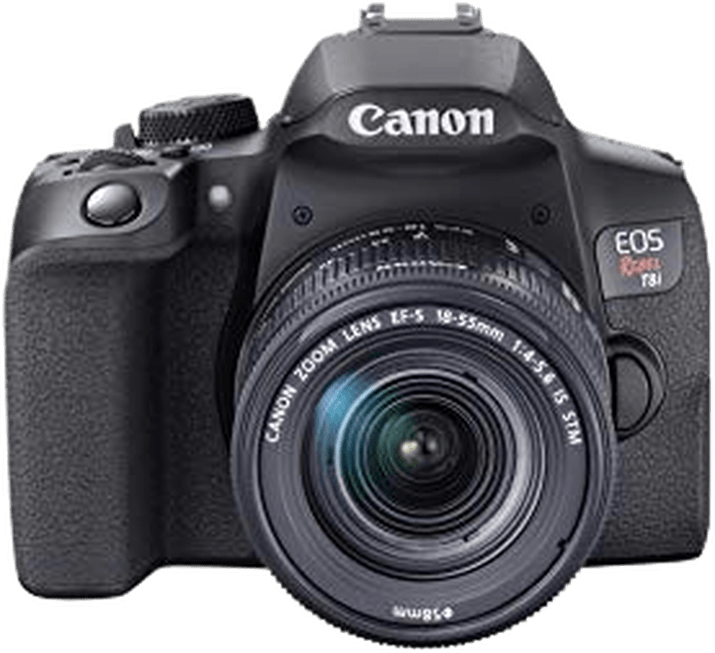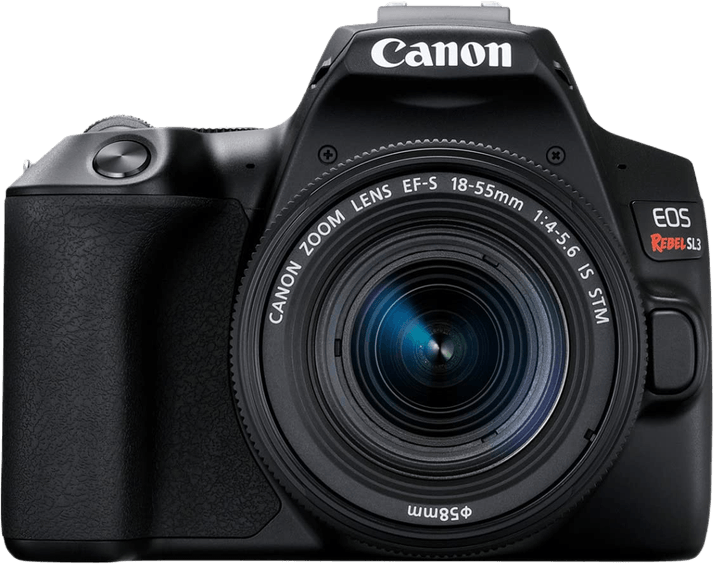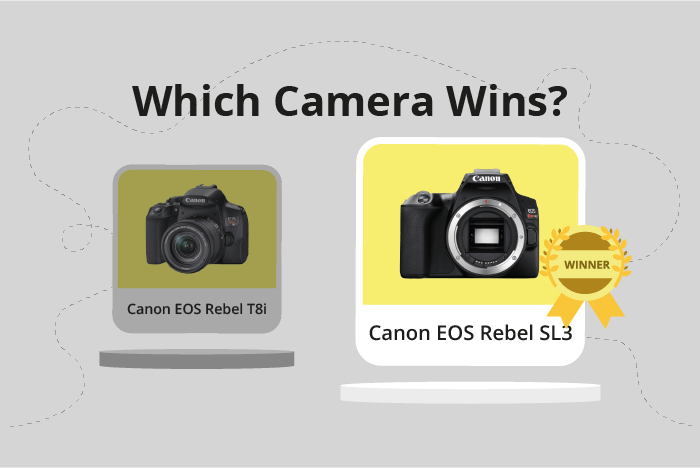Canon EOS Rebel T8i / 850D vs Rebel EOS SL3 / 250D Comparison
Canon EOS Rebel T8i / 850D

Canon EOS Rebel SL3 / 250D

The Canon Rebel EOS SL3 / 250D emerges as the winner with a score of 63/100, while the Canon EOS Rebel T8i / 850D trails behind with a score of 59/100. Both cameras share similarities as they are DSLR cameras, announced within a year of each other, and have similar launch prices.
The Canon Rebel EOS SL3 / 250D has its advantages, including a lighter weight of 449g and smaller dimensions (122 x 93 x 70mm), making it more portable and convenient for users. On the other hand, the Canon EOS Rebel T8i / 850D, despite its lower score, has a slightly larger size (131 x 103 x 76mm) and heavier weight (515g), which may offer a more robust feel for some users.
Considering the scores and specifications, the Canon Rebel EOS SL3 / 250D proves to be the better option for those seeking a more compact and lightweight DSLR camera, while the Canon EOS Rebel T8i / 850D may appeal to users who prefer a slightly larger and heftier camera body.
Canon EOS Rebel T8i / 850D vs Rebel EOS SL3 / 250D Overview and Optics
The Canon Rebel EOS SL3 / 250D triumphs over the Canon EOS Rebel T8i / 850D in optics, scoring 61/100 compared to the T8i’s 57/100. Both cameras share several specifications, including 24 megapixels, CMOS sensor type, Digic 8 processor, APS-C sensor size, and Canon EF/EF-S lens mount.
The SL3 / 250D outperforms the T8i / 850D with its higher DXOMARK sensor score of 64, which contributes to better image quality. Additionally, the SL3 / 250D has built-in image stabilization, ensuring sharper images and reducing the impact of camera shake during handheld shooting.
The T8i / 850D, however, boasts a faster shooting speed of 7.5 frames per second, making it more suitable for capturing fast-moving subjects or action scenes. This advantage may appeal to photographers who prioritize speed over image stabilization.
In terms of optics, the Canon Rebel EOS SL3 / 250D emerges as the superior choice due to its higher DXOMARK sensor score and image stabilization feature. These attributes result in enhanced image quality and reduced camera shake, making it an ideal option for photographers seeking improved performance in these areas. On the other hand, the Canon EOS Rebel T8i / 850D’s advantage in shooting speed may be more appealing to those who prioritize capturing fast-paced scenes. Ultimately, the choice between these two cameras depends on the specific needs and priorities of the photographer.
Canon EOS Rebel T8i / 850D vs Rebel EOS SL3 / 250D Video Performance
The Canon EOS Rebel T8i / 850D and Canon Rebel EOS SL3 / 250D both have a video score of 83/100, showing that they share similar video capabilities. Both cameras offer a maximum video resolution of 4K and video dimensions of 3840 x 2160. They also have a maximum video frame rate of 60fps and built-in time-lapse functionality.
Since both cameras have the same video score, neither is better in terms of video capabilities. They share identical specs in maximum video resolution, video dimensions, frame rate, and time-lapse functionality. These features make both cameras suitable for high-quality video recording and time-lapse photography.
While neither camera is superior in terms of video capabilities, they may have differences in other aspects, such as size, weight, or additional features. However, based on the provided specifications, the Canon EOS Rebel T8i / 850D and Canon Rebel EOS SL3 / 250D are equally competent in video performance.
Considering the equal video scores and shared specs, potential buyers can confidently choose either camera for their video needs. Both cameras provide high-quality video recording with 4K resolution and 60fps frame rate, as well as time-lapse functionality. Buyers should look into other factors, such as price or additional features, to determine which camera is the best fit for their specific requirements.
Canon EOS Rebel T8i / 850D vs Rebel EOS SL3 / 250D Features and Benefits
The Canon EOS Rebel T8i / 850D and Canon Rebel EOS SL3 / 250D both have a feature score of 70/100, making them equal in terms of specifications. In this comparison, we will examine their shared features, their unique advantages, and draw conclusions about their capabilities.
Both cameras have a 3-inch screen with a resolution of 1,040,000 dots, a touchscreen, and a flip screen. They also lack GPS but include WIFI and Bluetooth connectivity. These common features make the two models similar in terms of user experience and functionality.
Despite having the same score, the T8i / 850D does have some advantages over the SL3 / 250D. The T8i / 850D has a higher continuous shooting rate, better low-light performance, and a more advanced autofocus system. These factors contribute to the T8i / 850D being a better choice for action and low-light photography.
On the other hand, the SL3 / 250D is more compact and lightweight, making it more portable and easier to carry around. This advantage is particularly beneficial for casual photographers who prioritize convenience and portability.
Considering the shared features and unique advantages of both cameras, the T8i / 850D is the better choice for action and low-light photography, while the SL3 / 250D is more suitable for those who prioritize portability. Ultimately, the decision between the two models depends on the specific needs and preferences of the photographer.
Canon EOS Rebel T8i / 850D vs Rebel EOS SL3 / 250D Storage and Battery
The Canon Rebel EOS SL3 / 250D wins in the storage and battery comparison with a score of 45/100, while the Canon EOS Rebel T8i / 850D scores 35/100. Both cameras have one memory card slot and accept SD, SDHC, and SDXC (UHS-I compatible) memory cards. They also use the same LP-E17 battery type and do not support USB charging.
The SL3 / 250D outperforms the T8i / 850D in battery life, offering 1070 shots compared to the T8i / 850D’s 800 shots. This longer battery life makes the SL3 / 250D more suitable for extended shooting sessions without the need for frequent battery replacements or recharging.
The T8i / 850D does not have any advantages in storage and battery over the SL3 / 250D. The only difference is its shorter battery life, which may not be a significant factor for casual photographers but could be a drawback for those who require more shooting time.
Considering the storage and battery aspects, the Canon Rebel EOS SL3 / 250D is the better choice due to its longer battery life. The Canon EOS Rebel T8i / 850D falls short in this aspect, making it less suitable for extended photography sessions.
Alternatives to the Canon EOS Rebel T8i / 850D and Rebel EOS SL3 / 250D
Are you still undecided about which camera is right for you? Have a look at these popular comparisons that feature the Canon EOS Rebel T8i / 850D or the Canon Rebel EOS SL3 / 250D:

